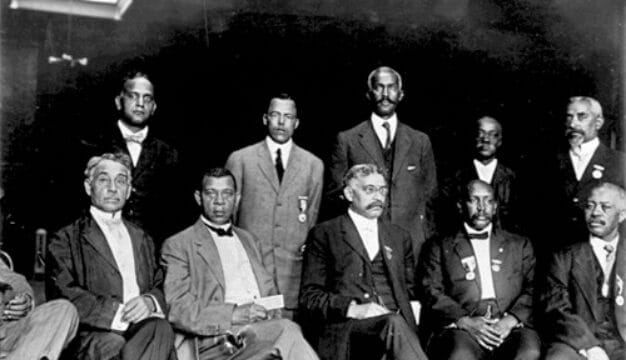Russell County
 Horace King
Located in the southeastern part of the state, Russell County is known as the “County of Forts,” because of the many forts that once existed within its boundaries, including Fort Mitchell, Fort Apalachicola, Sand Fort, Fort Bainbridge, and a small portion of present-day Fort Moore (formerly Fort Benning), most of which is in Georgia. Fort Mitchell National Cemetery, established in 1987, will be the final resting place for many veterans in the Southeast. Russell County was the home of Horace King, an enslaved African American engineer and bridge designer who oversaw construction of many bridges in the southeast. Military and political figure William P. Screws was born in Russell County. Phenix City gained national renown, including being featured in the Hollywood film The Phenix City Story, when politician and attorney Albert L. Patterson was murdered for his efforts to clean up organized crime in the city. The county is governed by an elected seven-member commission and includes two incorporated communities.
Horace King
Located in the southeastern part of the state, Russell County is known as the “County of Forts,” because of the many forts that once existed within its boundaries, including Fort Mitchell, Fort Apalachicola, Sand Fort, Fort Bainbridge, and a small portion of present-day Fort Moore (formerly Fort Benning), most of which is in Georgia. Fort Mitchell National Cemetery, established in 1987, will be the final resting place for many veterans in the Southeast. Russell County was the home of Horace King, an enslaved African American engineer and bridge designer who oversaw construction of many bridges in the southeast. Military and political figure William P. Screws was born in Russell County. Phenix City gained national renown, including being featured in the Hollywood film The Phenix City Story, when politician and attorney Albert L. Patterson was murdered for his efforts to clean up organized crime in the city. The county is governed by an elected seven-member commission and includes two incorporated communities.
- Founding Date: December 18, 1832
- Area: 639 square miles
- Population: 57,938 (2020 Census estimate)
- Major Waterways: Chattahoochee River, Big Uchee Creek
- Major Highways: U.S. 80, U.S. 431
- County Seat: Phenix City
- Largest City: Phenix City
History
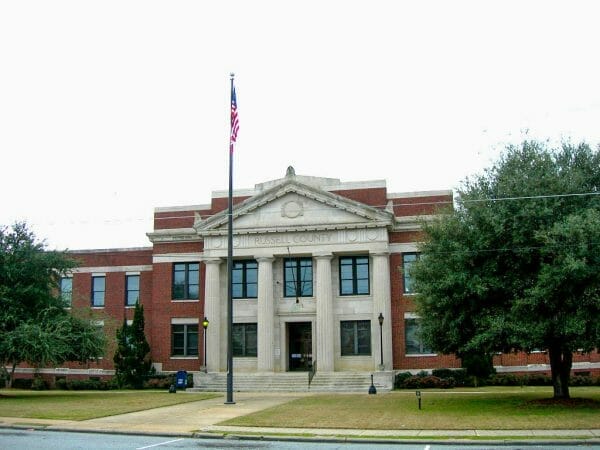 Russell County Courthouse
Russell County was created by the Alabama state legislature on December 18, 1832; the present geographical boundaries were not established until 1932, however. The county was created from former Creek Indian lands, and the remains of several Indian villages, cemeteries, and mounds are still evident. Russell County was named in honor of Col. Gilbert C. Russell of Mobile, a U.S. military officer who fought in the Creek War of 1813-14. Early settlement of Russell County as well as other parts of Alabama followed the establishment of Fort Mitchell. The fort was constructed by Georgia militia in 1813 during the Creek War to provide military protection for non-Indians settling in the area. Most of Russell County’s early settlers came from Georgia, the Carolinas, and Virginia. In 1820, politician, racehorse breeder, and Indian agent John Crowell moved to the area to represent the federal government among the Creeks.
Russell County Courthouse
Russell County was created by the Alabama state legislature on December 18, 1832; the present geographical boundaries were not established until 1932, however. The county was created from former Creek Indian lands, and the remains of several Indian villages, cemeteries, and mounds are still evident. Russell County was named in honor of Col. Gilbert C. Russell of Mobile, a U.S. military officer who fought in the Creek War of 1813-14. Early settlement of Russell County as well as other parts of Alabama followed the establishment of Fort Mitchell. The fort was constructed by Georgia militia in 1813 during the Creek War to provide military protection for non-Indians settling in the area. Most of Russell County’s early settlers came from Georgia, the Carolinas, and Virginia. In 1820, politician, racehorse breeder, and Indian agent John Crowell moved to the area to represent the federal government among the Creeks.
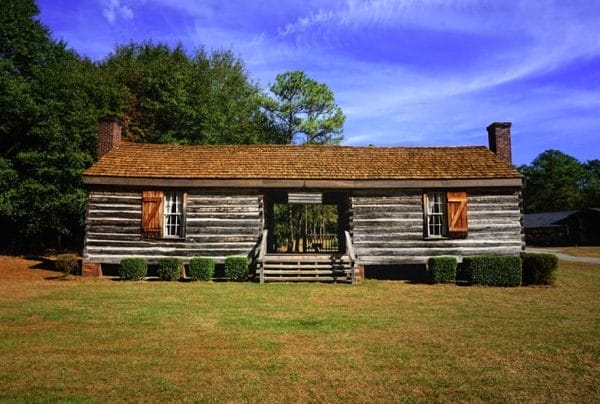 Dogtrot Cabin at Fort Mitchell
The first permanent settlement in Russell County, established in 1830, was Glennville Beat. Other early settlements and towns included Cottonton, Uchee, Sandfort, Hatchechubbee, Crawford, Hurtsboro, and Girard. The Battle of Columbus, which took place on April 16, 1865, in both Girard and Columbus, Georgia, was one of the last land battles of the Civil War. It was fought one week after Gen. Robert E. Lee surrendered at Appomattox Court House, Virginia, because of the slow pace of communication. The action ended when U.S. Army major general James H. Wilson and his troops captured the two bridges connecting Girard and Columbus, thus gaining access to the entire state of Georgia.
Dogtrot Cabin at Fort Mitchell
The first permanent settlement in Russell County, established in 1830, was Glennville Beat. Other early settlements and towns included Cottonton, Uchee, Sandfort, Hatchechubbee, Crawford, Hurtsboro, and Girard. The Battle of Columbus, which took place on April 16, 1865, in both Girard and Columbus, Georgia, was one of the last land battles of the Civil War. It was fought one week after Gen. Robert E. Lee surrendered at Appomattox Court House, Virginia, because of the slow pace of communication. The action ended when U.S. Army major general James H. Wilson and his troops captured the two bridges connecting Girard and Columbus, thus gaining access to the entire state of Georgia.
In 1832, Girard became the first county seat. A storehouse served as the courthouse from 1832 to 1834, at which time the county seat was moved to Crawford (formerly known as Crocketsville). A permanent brick courthouse was built in Crawford in 1842 and used until 1868, when it became a church. It was demolished in 1901. In 1868, the county seat was moved to Seale, where a brick courthouse was built. In 1926, Russell County established dual county seats in Seale and Phenix City. The two towns shared administrative duties until 1934, when Phenix City became the sole county seat. The courthouse in Seale served several functions after 1934, including as a school gym and meeting house. In 1974, the building was restored and now serves as a meeting place for community groups and houses the town’s natural history collection.
Major Cities and Demographics
 Old Courthouse in Seale
According to 2020 Census estimates, the population of Russell County was 57,938. Of that total, 47.8 percent of respondents identified themselves as white, 44.9 percent as African American, 5.6 percent as Hispanic, 3.3 percent as two or more races, 1.2 percent as Asian, 0.1 percent as Hawaiian or Pacific Islander, and 0.1 percent as Native American. The county seat Phenix City is the largest city in the county with an estimated population of 34,461. Other significant population centers include Ladonia and Hurtsboro. The median household income was $42,208, compared with $52,035 for the state as a whole, and the per capita income was $24,300, compared with $28,934 for the state as a whole.
Old Courthouse in Seale
According to 2020 Census estimates, the population of Russell County was 57,938. Of that total, 47.8 percent of respondents identified themselves as white, 44.9 percent as African American, 5.6 percent as Hispanic, 3.3 percent as two or more races, 1.2 percent as Asian, 0.1 percent as Hawaiian or Pacific Islander, and 0.1 percent as Native American. The county seat Phenix City is the largest city in the county with an estimated population of 34,461. Other significant population centers include Ladonia and Hurtsboro. The median household income was $42,208, compared with $52,035 for the state as a whole, and the per capita income was $24,300, compared with $28,934 for the state as a whole.
Economy
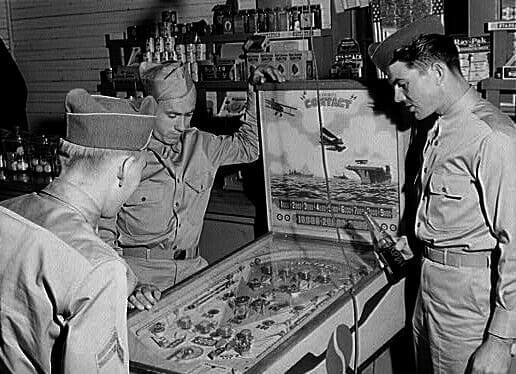 Soldiers from Fort Benning
Like most of Alabama’s counties, farming was the prevailing occupation in Russell until well into the twentieth century. Cotton, corn, and cattle served as the county’s main agricultural activities. With easy access to the Chattahoochee River and Georgia markets, however, shipping and other forms of transportation became an important part of Russell’s economy in the nineteenth and twentieth centuries. When the river was dammed in the 1940s, hydroelectric power led to the development of industry, including textile manufacturing. After the decline of the textile industry in the state, many residents gained employment in the medical industry, largely in Columbus, Georgia. Columbus State University is also a major employer.
Soldiers from Fort Benning
Like most of Alabama’s counties, farming was the prevailing occupation in Russell until well into the twentieth century. Cotton, corn, and cattle served as the county’s main agricultural activities. With easy access to the Chattahoochee River and Georgia markets, however, shipping and other forms of transportation became an important part of Russell’s economy in the nineteenth and twentieth centuries. When the river was dammed in the 1940s, hydroelectric power led to the development of industry, including textile manufacturing. After the decline of the textile industry in the state, many residents gained employment in the medical industry, largely in Columbus, Georgia. Columbus State University is also a major employer.
Employment
According to 2020 Census estimates, the workforce in Russell County was divided among the following industrial categories:
- Educational services, and health care and social assistance (20.3 percent)
- Retail trade (15.0 percent)
- Manufacturing (13.9 percent)
- Arts, entertainment, recreation, and accommodation and food services (8.9 percent)
- Professional, scientific, management, and administrative and waste management services (8.8 percent)
- Finance and insurance, and real estate, rental, and leasing (8.2 percent)
- Public administration (7.6 percent)
- Construction (5.9 percent)
- Transportation and warehousing, and utilities (4.8 percent)
- Other services, except public administration (3.6 percent)
- Information (1.1 percent)
- Wholesale trade (1.0 percent)
- Agriculture, forestry, fishing and hunting, and extractive (0.9 percent)
Education
The Russell County School System oversees eight primary and secondary schools; and the Phenix City School System oversees three primary and secondary schools. The Phenix City branch of Troy University offers degrees in business, counseling, education, and nursing. Chattahoochee Valley Community College, a two-year institution also located in Phenix City, offers academic, technical, and vocational programs.
Geography
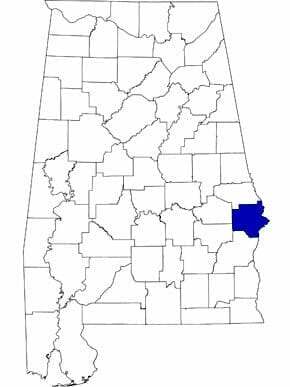 Russell County Map
Encompassing 639 square miles, Russell County is located wholly within the Coastal Plain physiographic section and consists of low, rolling clay hills and sandy-bottomed rivers and streams. Russell County is bordered to the east by Georgia, to the north by Lee County, to the west by Macon and Bullock Counties, and to the south by Barbour County.
Russell County Map
Encompassing 639 square miles, Russell County is located wholly within the Coastal Plain physiographic section and consists of low, rolling clay hills and sandy-bottomed rivers and streams. Russell County is bordered to the east by Georgia, to the north by Lee County, to the west by Macon and Bullock Counties, and to the south by Barbour County.
The Chattahoochee River runs along the county’s eastern border, and the river’s many tributaries fan out through the entire county. Because the Chattahoochee River is one of the most dammed rivers in the southeast, its physical and biological systems have been severely altered over the last half century. The overall biological diversity of the river has declined, and several fish and mussel species are at risk.
U.S. highways 80 and 431 are Russell County’s major transportation routes. U.S. Highway 80 runs east-west across the northernmost part of the county. U.S. Highway 431 runs northeast-southwest through the middle of the county. There are no public airports in Russell County, but the Columbus Airport in Columbus, Georgia, is easily accessible.
Events and Places of Interest
 Sacred Fire at the Chattahoochee Indian Heritage Center
There are a number of recreational opportunities and historically important sites in Russell County. The Phenix City Amphitheater is located on the western bank of the Chattahoochee River. With seating for 1,500 people, the amphitheater hosts a multitude of civic and cultural events throughout the year. The amphitheater also serves as the anchor point for the RiverWalk walkway and bicycle trail.
Sacred Fire at the Chattahoochee Indian Heritage Center
There are a number of recreational opportunities and historically important sites in Russell County. The Phenix City Amphitheater is located on the western bank of the Chattahoochee River. With seating for 1,500 people, the amphitheater hosts a multitude of civic and cultural events throughout the year. The amphitheater also serves as the anchor point for the RiverWalk walkway and bicycle trail.
The Russell County Historical Commission-Fort Mitchell Historic Site is open to the public and includes John Crowell’s original dogtrot cabin. Known as the Gateway to the West, Fort Mitchell played a significant part in the settlement history of the region and was a starting point for the forced removal of Creek Indians from the region. Visitors can tour the 1813 fort with its defensive moat, 12-foot-high palisade, houses, and barracks. The Chattahoochee Indian Heritage Center is located near the site of the original fort and features displays documenting the contributions and history of Native Americans in the Southeast.
 East Alabama Motor Speedway
The East Alabama Motor Speedway in Phenix City hosts six classes of championship stock-car racing every Saturday night from March to October. Special events include demolition derbies, fireworks, and sprint-car races. The Mural at Idle Hour Park, also located in Phenix City, is 28 feet tall and 140 feet long and depicts the midway of Phenix City in the 1940s. The mural includes scenes of carousels, trains, skating, a zoo, a dance hall, and a Ferris wheel. Russell County hosts a number of festivals each year. Thunder on the Hooch is a Fourth of July extravaganza that takes place on both sides of the Chattahoochee River in Columbus, Georgia, and Phenix City. The event includes music, games, carnival rides, food, arts and crafts, and fireworks. Each May, Phenix City hosts the Hometown Hoedown, which includes country music performances, square dancing, food, and games. The annual Festival of Art takes place in Phenix City each October and promotes the work of local artists and craftsmen.
East Alabama Motor Speedway
The East Alabama Motor Speedway in Phenix City hosts six classes of championship stock-car racing every Saturday night from March to October. Special events include demolition derbies, fireworks, and sprint-car races. The Mural at Idle Hour Park, also located in Phenix City, is 28 feet tall and 140 feet long and depicts the midway of Phenix City in the 1940s. The mural includes scenes of carousels, trains, skating, a zoo, a dance hall, and a Ferris wheel. Russell County hosts a number of festivals each year. Thunder on the Hooch is a Fourth of July extravaganza that takes place on both sides of the Chattahoochee River in Columbus, Georgia, and Phenix City. The event includes music, games, carnival rides, food, arts and crafts, and fireworks. Each May, Phenix City hosts the Hometown Hoedown, which includes country music performances, square dancing, food, and games. The annual Festival of Art takes place in Phenix City each October and promotes the work of local artists and craftsmen.
Further Reading
- The Heritage of Russell County, Alabama. Clanton, Ala.: Heritage Publishing Consultants, 2003.
- Russell County Historical Commission. The History of Russell County, Alabama. Dallas: National ShareGraphics, 1982.
External Links
- Russell County
- Russell County School District
- City of Phenix City
- Town of Hurtsboro
- East Alabama Chamber of Commerce
- National Register of Historic Places: Russell County
- Troy University, Phenix City Campus
- Chattahoochee Valley Community College
- Fort Mitchell and Chattahoochee Indian Heritage Center
- East Alabama Motor Speedway
